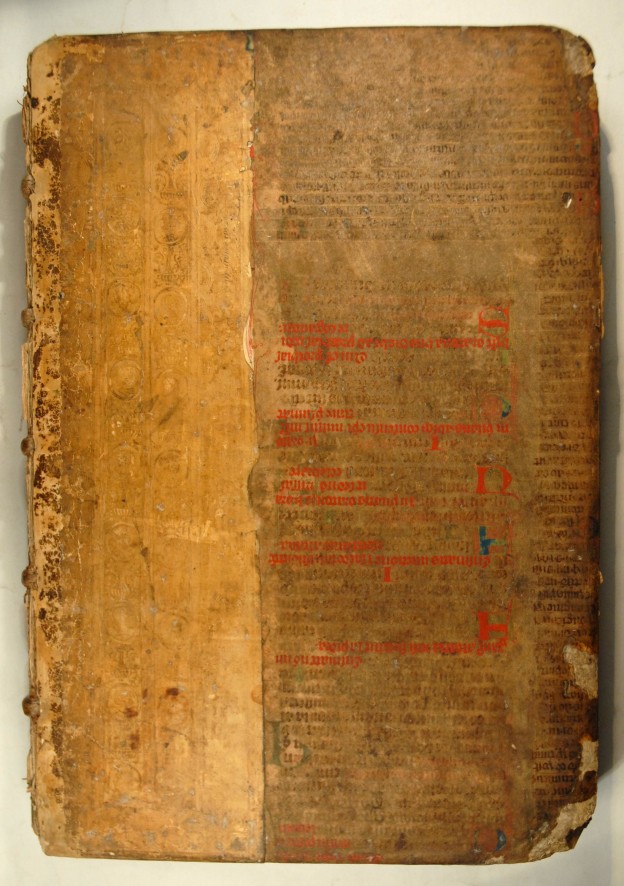AGRICOLA, Georgius (BAUER, Georg)
De re metallica libri XII - De animantibus subterraneis liber
Basel, Hieronymus Froben and Nicolaus Bischoff, 1561£12,500.00
Folio, pp. [xii] 502 [lxxiv]. Roman, Greek and Gothic letter. Woodcut printer’s device on title and verso of last, two woodcut plates, one folding, a total of 273 large woodcut illustrations and diagrams in good clean impression, some full-page, white on black initials. Light age yellowing, a few marginal spots and splashes, clean tear without any loss in one leaf, early ms press mark to t-p and later, but not modern, to pastedown. A good, clean wide-margined copy. Formerly in contemporary 1/4 pigskin over paste-boards, the pigskin removed exposing stitching and binder’s waste, cover from a ms. on vellum in red and brown ink, decorated initials, early 1400’s. In folding box.
SECOND EDITION of the “first systematic treatise on mining and metallurgy and one of the first technological books of modern times” (PMM), the earliest and pre-eminent early work on metallurgy and mining. It is remarkably richly illustrated with technical woodcuts of the highest quality, largely by Hans Rudolf Manuel Deutsch (after Blasius Weffring). All of them are based on Agricola’s own drawings of processes and phenomena he personally observed. The work “embraces everything connected with the mining industry and metallurgical processes, including administration, prospecting, the duties of officials and companies and the manufacture of glass, sulphur and alum. The magnificent series of two hundred and seventy three large woodcut illustrations…add to its value. Some of the most important sections are those on mechanical engineering and the use of water power, hauling pumps, ventilation, blowing of furnaces, transport of ores etc., showing a very elaborate technique” (PMM). It is “one of the great monuments of technology by reason of the comprehensiveness of its text and the detail and intelligibility of its numerous illustrations” (Singer, vol II, p. 27), and became “the early standard treatise” on the subject (Horblit, 2b). It is also one of the important contributions to physical geology, in particular the influence of wind and water erosion on landscape and its clear account of the order of strata exposed by mines. The work concludes with a 20 page glossary of technical terms and names in Latin and German which contains a new scientific classification of minerals based on their physical properties; the mode of occurrence and mutual relation of some 80 minerals and ores are discussed, no less than 21 of them for the first time.
Written over two decades, the work illustrates Bauer’s familiarity both with the technical and financial aspects of mining as well as his concern for the health of the miners. Bauer had studied medicine in Leipzig before moving to the important mining centre of Joachimstal (in latter-day Czechoslovakia) as the town physician. There, Bauer observed both by day and by night the unceasing activities of the mines, “and his interests were aroused by the metallurgical, mineralogical and chemical problems of the trade. He published several books relating to these, the above is outstanding in the field of all science and technology; it was published posthumously. Many large woodcuts present vivid pictures of men at work, machines pumping, ventilating, smelting, assaying, transportation, and hoisting equipment and methods of his time” (Dibner, Heralds of Science, 88). The work was translated into English in 1912 by Herbert Hoover, afterwards president of the United States.
BM STC Ger. p.8; Adams A-350; PMM 79 (1st edn); Brunet I, 113; Horblit, One Hundred Books Famous in Science, 2 (1st); Duveen pp. 4-5; Ferguson I, p.9; Kress I, 71 (1st); Ford, Images of Science, pp. 124-5; Norman 20.In stock








